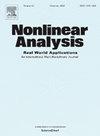An L∞-estimate for solutions to p-Laplacian type equations using an obstacle approach and applications
IF 1.8
3区 数学
Q1 MATHEMATICS, APPLIED
引用次数: 0
Abstract
In this paper, we will address a version of the -estimate for weak solutions of Laplacian type equations of the form where , () is a suitable domain (possibly unbounded with finite measure), with and and is a continuous vector field satisfying certain structural properties. Unlike the non-variational scenario, our approach is based on analyzing an obstacle problem associated with our equation and exploring its intrinsic qualitative properties. Additionally, in some scenarios, our estimates bring to light new geometric quantities that are not present in the results of the classic literature. At the end, we will present some applications of our estimates, which may be essential in certain contexts of quasi-linear PDEs and related topics.
求助全文
约1分钟内获得全文
求助全文
来源期刊
CiteScore
3.80
自引率
5.00%
发文量
176
审稿时长
59 days
期刊介绍:
Nonlinear Analysis: Real World Applications welcomes all research articles of the highest quality with special emphasis on applying techniques of nonlinear analysis to model and to treat nonlinear phenomena with which nature confronts us. Coverage of applications includes any branch of science and technology such as solid and fluid mechanics, material science, mathematical biology and chemistry, control theory, and inverse problems.
The aim of Nonlinear Analysis: Real World Applications is to publish articles which are predominantly devoted to employing methods and techniques from analysis, including partial differential equations, functional analysis, dynamical systems and evolution equations, calculus of variations, and bifurcations theory.

 求助内容:
求助内容: 应助结果提醒方式:
应助结果提醒方式:


